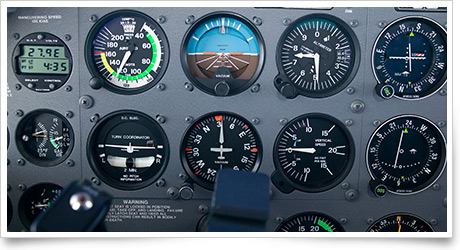| The following stories from the June 22, 2012, edition of AOPA ePilot were provided to AOPA members who expressed an interest in the particular subject areas. Any AOPA member can receive information tailored to their areas of interest by updating their preferences online |
training tipsSources and methods
You're doing fine—so why does the CFI still look displeased?
"Your altitude is a hundred feet off!" he growls.
No it's not—it's right on the money, you think to yourself after a reassuring glance at the altimeter. Can't the CFI read the instrument from way over there in the right seat?
That's when the light goes on in your head: Your pitot-static instruments are using the alternate static source in this simulated system-failure drill. The CFI is reminding you that you must consult your pilot's operating handbook for inaccurate or erroneous instrument indications under various in-flight circumstances. You are already coping with one such predicament on this flight by making each course change using only the swinging, dipping magnetic compass for guidance.
The alternate static source—usually positioned just below the throttle on Cessna 172s, and an option on Piper Warrior IIs—comes with its own set of operational considerations. It supplies static pressure from inside the cabin instead of at an external static port. That means that such things as open heaters, vents, and windows can affect instrument readings.
How much? That depends on the aircraft. A performance chart for a Cessna 182S Skylane operating with the alternate static source in use indicates that the altimeter may be off by 100 feet or more at some airspeeds.
And, speaking of open windows, one of the first things you will probably do after landing and taxiing clear on this sultry day is open them and enjoy a bit of fresh air as you taxi in. Your instructor, now playing the role of a future passenger, wants to know if they can be opened right now, in flight.
What's the answer for your aircraft? The Cessna 182S pilot's operating handbook says windows may be opened at any speed up to 175 knots indicated airspeed. training productsSporty's E6B Android aviation appAndroid users can now utilize an app that provides an electronic E6B with all traditional functions. The app includes 23 aviation functions, 18 conversions, and timer features. Each function can be selected from a plain English list, and the app prompts the user for information as it goes. Entries are saved from previous calculations. The app is compatible with Android 1.5 and higher, including almost all phones and tablets such as the Xoom and the Galaxy Tab. The app sells for $9.99 and may be ordered online.
Note: Products listed have not been evaluated by ePilot editors unless otherwise noted. AOPA assumes no responsibility for products or services listed or for claims or actions by manufacturers or vendors. final examQuestion: On a night flight recently, I identified the flashing white and green beacon of my intended airport. Not far away though, I noticed a flashing white, green, and yellow beacon. What was I looking at?
Answer: A beacon that flashes green, yellow, and white indicates a lighted heliport. Beacons that mark heliports usually flash at a rate of 30 to 45 flashes per minute. Other beacon color combinations include white and green for lighted land airports and white and yellow for lighted water airports. These beacons usually flash 24 to 30 times per minute. For more information on beacons, see Section 2-1-10 of the Aeronautical Information Manual. For more on night flying, read this article from Flight Training magazine.
Got a question for our technical services staff? Email [email protected] or call the Pilot Information Center, 800/872-2672. Don’t forget the online archive of “Final Exam” questions and answers, searchable by keyword or topic. |
 Aloft in bumpy currents of unevenly heated air on a summer day, you feel a touch of pride as you hold altitude precisely en route to your cross-country destination. This wasn't always your favorite task. Now your satisfaction almost makes you forget the various inconveniences your instructor has imposed by "failing" your electronic navigation, "blocking" the
Aloft in bumpy currents of unevenly heated air on a summer day, you feel a touch of pride as you hold altitude precisely en route to your cross-country destination. This wasn't always your favorite task. Now your satisfaction almost makes you forget the various inconveniences your instructor has imposed by "failing" your electronic navigation, "blocking" the 

